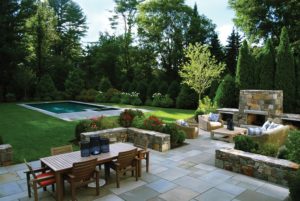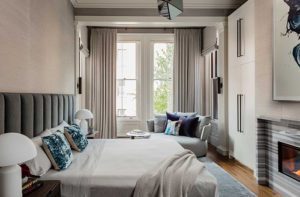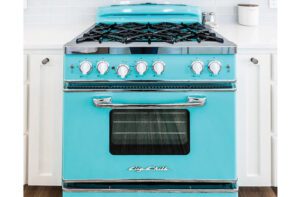Designer Kellie Burke’s Home
April 13, 2017
A designer unleashes her creativity in her own Hartford home, creating a space that reflects her unique and playful perspective on decorating.
Text by Fred Albert Photography by Michael Partenio Produced by Stacy Kunstel


Growing up as a tomboy in Avon, Kellie Burke was determined to do everything her three brothers did—only better and faster. By the time she got to Skidmore College, though, she’d traded her shredded jeans for red lizard boots and a rhinestone cowboy hat. “I don’t think I’ve ever really blended in my whole life,” confesses the interior designer. “I like to be a little over the top. Maybe a lot over the top.”
For confirmation, you needn’t look any further than Burke’s Norman-style manse on Hartford’s Governors Row, on the West End/West Hartford line. Unbridled unconventionality reigns in the 11,000-square-foot home, which overlays Old World elegance with a punk sensibility that’s both cunning and cozy.
From the faux-alligator wallpaper adorning the kitchen to the Don-Draper-meets-Downton-Abbey decor in the family room, this is a house that proclaims its independence at every turn.
Burke has dreamed of living in this area since second grade, when she got her first glimpse of the historic neighborhood. “I’m definitely going to live there one day,” she informed her parents (and anyone else who would listen). She made good on that promise seventeen years ago, when she and her husband, entrepreneur Mark Zeytoonjian, purchased their first West End property. When their current house came on the market in 2006, she snatched it up, beguiled by the 1920s glamour she glimpsed beneath the shag carpeting and floor-to-ceiling florals. “The first thing I did was install the disco ball,” says Burke, referring to the glittering bauble dangling from the ceiling of the ballroom-cum-family room. The forty-four-by-twenty-one-foot space was Party Central for the home’s first resident, former Republican governor Henry Roberts (whose political affiliation is commemorated in the brass elephant heads adorning the bar). While symphony orchestras no longer serenade guests as they did in Roberts’s day, Burke and Zeytoonjian have entertained as many as 250 here, and the designer celebrated her fortieth birthday dancing atop the bar—alongside her brothers, of course.
Although the house was decorated with entertaining in mind, Burke wanted to make sure it also felt cozy and inviting. “I really wanted to wrap a person in there and make them feel warm,” she says. To that end, she chose pieces that are both big in scale and big in comfort, like the red damask wing chairs with their embracing curved backs, and the uncommonly deep sectional covered in what Burke calls “Elvis blue velvet,” where she, Zeytoonjian, and their young son, Finley, can sprawl in front of the TV at night.
A second seating group beside it is more Mad Men than Masterpiece Theatre, with midcentury modern–style chairs resting atop a round, leopard-patterned rug. “I love anything with an animal print on it,” confides Burke. The Christian Lacroix carpet in the living room is a modern riff on zebra, which Burke paired with an opulent recamier covered in an exuberant fabric that echoes the color of the zebra but not its scale, so the two don’t clash.
Zeytoonjian learned long ago not to question his wife’s vision. The year they were married, she painted their foyer in pink and yellow stripes over his objections. When visitors kept marveling at the choice, Zeytoonjian had to admit that his wife was right all along, and has never interfered with her design choices since.
So when she decided to paper the entry hall of their new home in a colorful chevron pattern, he didn’t blink an eye. The adjoining dining room is a bit more subdued, but even here, Burke took some liberties, painting the walls a drab army green—a sober rejoinder to the opulent carved woods populating the space. As in the rest of the house, portraits dot the walls, harkening back to Burke’s collegiate work as a figurative painter.
Burke’s early art training influences her decorating in other ways, too. “When you’re painting, you always have to have this pop of color to make the painting sing,” says the designer, whose striped magenta loveseat punctuates the master bedroom like a chromatic exclamation mark.
A year and a half ago, the couple completed a total kitchen remodel, then headed to the Bahamas on vacation. They returned two weeks later to find a sheet of ice blanketing the driveway. Puzzled, Burke stepped into the kitchen and looked up. “I could see all the way to the attic,” she says. “There had been a flood—a pipe had burst—and all of the ceilings had collapsed.
“My husband saw dollar signs,” she adds. “I saw opportunity.”
Instead of replicating the kitchen she had just completed, Burke decided to take a whole new approach, expanding the space so it would be more in keeping with the overall scale of the house. By eliminating the old servant’s quarters above, she was able to raise the ceiling to twenty-two feet and install massive floating timbers overhead. “I wanted the rustic beams that you would see in a vintage castle, mixed with ornate, embellished, Gilded Age–style cabinetry,” she says.
To achieve that bygone look, voluptuous Habersham cabinets were treated to seventeen coats of paint, which were sanded and distressed to expose the encrusted layers underneath. A large lantern topped with a beaded peacock-feather canopy illuminates the room, which sports faux patent-leather walls in a crocodile pattern and breakfast chairs finished with hand-rubbed silver foil and matching leather.
To Burke, it would have been criminal to crown all this elegance with a painted plasterboard ceiling. “One of my biggest nemeses in life is Sheetrock,” she says. “I feel like it’s too new, so I’m always trying to camouflage it.” A Kelly Wearstler paper in a black-and-white crosshatch does the job, adding graphic impact overhead.
Burke did a similar thing in the master bath, covering the drywall in broad black-and-white stripes. The bold graphic offers a contemporary counterpoint to the ornate, Rococo-style vanity in front of it.
“This house can be taken too seriously if you don’t have a little fun with it,” notes Burke. As long as this unabashedly unrestrained designer remains in charge, solemnity will never be a problem. •
Interior design: Kellie Burke, Kellie Burke Interiors
Kitchen Architecture: Jack Kemper, Kemper Associates Architects
Share
![NEH-Logo_Black[1] NEH-Logo_Black[1]](https://www.nehomemag.com/wp-content/uploads/2022/08/NEH-Logo_Black1-300x162.jpg)






















You must be logged in to post a comment.